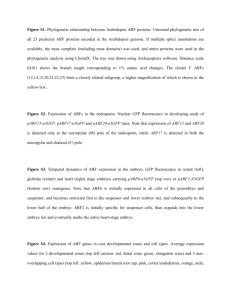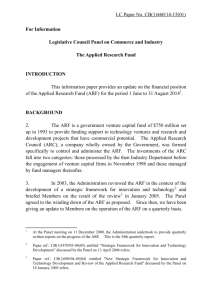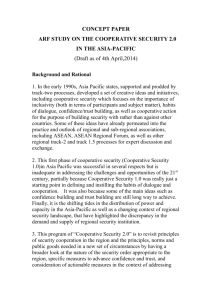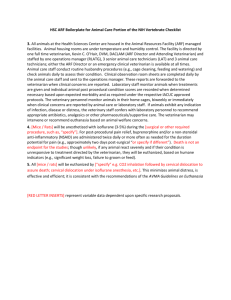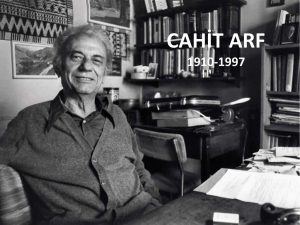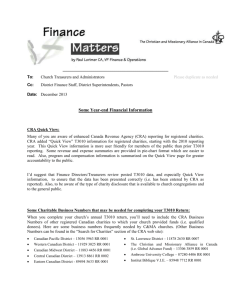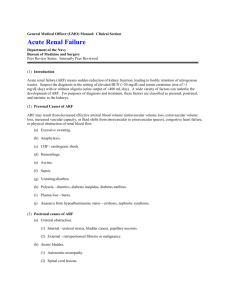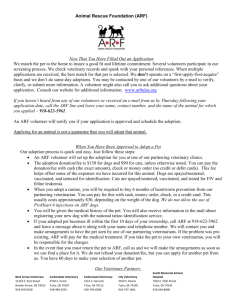pptx
advertisement
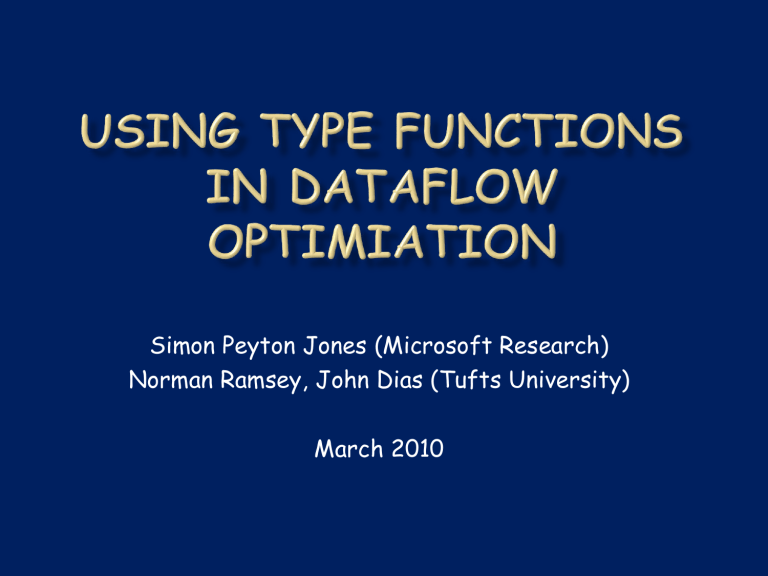
Simon Peyton Jones (Microsoft Research)
Norman Ramsey, John Dias (Tufts University)
March 2010
X:=0
T:=0
Goto L1
L1
One entry,
perhaps many
exits
Each block has a
label
X:=X+1
T:=T+X
If X=10 goto L2 else goto L1
Each block is a
sequence of
nodes
Control transfers
at end of block
L2
Return T
Arbitrary control
flow
True
X := 3+4
x=7
Y := x > 5
x=5,
x=7, y=True
If y
then goto L2
else goto L3
L2
L3
Each analysis has
Data flow “facts”
Transfer
function for each
node
True
X := 3+4
Rewrite
X := 7
x=7
Y := x > 5
Y := True
x=5,
x=7, y=True
If y
then goto L2
else goto L3
L2
goto L2
L3
L2
Rewrite each node based on incoming dataflow fact
Feed rewritten node to the transfer function
Each rewrite takes
A node
The dataflow fact flowing to that node
and returns…what???
Correct answer: an arbitrary graph!
Examples: rewrite
an instruction to a no-op
a block-copy “instruction” to a loop
a switch “instruction” to a tree of conditionals
a call to the instantiated procedure body (inlining)
First time
round, we may
have bogus
information
X:=0
T:=0
Goto L1
X=0
L1
X:=X+1
T:=T+X
If X=10 goto L2 else goto L1
X=10
X=1?
L2
Return T
First time
round, we may
have bogus
information
X:=0
T:=0
Goto L1
X=0
L1
X=Top
X:=X+1
T:=T+X
If X=10 goto L2 else goto L1
Combine facts
flowing into a
block
X=10
L2
X=1
Return T
First time
round, we may
have bogus
information
X:=0
T:=0
Goto L1
X=0
L1
X=Top
X:=X+1
T:=T+X
If X=10 goto L2 else goto L1
Combine facts
flowing into a
block
X=10
L2
X=T
Return T
And iterate to
fixed point
Rewrites based
on bogus (nonfinal) “facts”
must be
discarded
But they must
still be done
(speculatively)
in order to
exploit current
“fact”
X:=0
T:=0
Goto L1
X=0
L1
X:=X+1
T:=T+X
If X<2 goto L2 else goto L1
X=1
L2
Return T
Dead
edge!
Many dataflow analyses and optimisations
can be done in this “analyse-and-rewrite”
framework
Interleaved rewriting and analysis is
essential
Can combine analyses into “super-analyses”.
Instead of A then B then A then B, do A&B.
Lerner, Grove, Chambers POPL 2002
Graph implemented using pointers
Facts decorate the graph; keeping them up
to date is painful
Rewrites implements as mutation; undoing
bogus rewrites is a major pain
Difficult and scary
Dataflow
lattice
Arbitrary
graph
Node
rewrite
function
Node
transfer
function
Hoopl
Optimised
graph
Interleaved rewriting and analysis
Shallow and deep rewriting
Fixpoint finding for arbitrary control flow
One function for forward dataflow, one for backward
Polymorphic in node and fact types
In Hoopl we have:
Nodes
Blocks
Graphs
All are parameterised by whether “shape”
Open/Closed on entry
Open/Closed on exit
Y := x > 5
goto L2
X=
φ(X1,X2)
Defined by client of Hoopl
Hoopl is polymorphic in node type
data O
data C
-- Defined
-by Hoopl
data Node e x where -- Defined by client
Head
:: Node C O
Assign
:: Reg -> Expr -> Node O O
Store
:: Expr -> Expr -> Node O O
Branch
:: BlockId -> Node O C
CondBranch :: BlockId -> BlockId -> Node O C
...more constructors...
data Block n e x where
-- Defined by Hoopl
BUnit :: n e x -> Block n e x
BCat :: Block n e O -> Block n O x -> Block n e x
Blocks are non-empty sequences of nodes
Only open/open joins are allowed
Type of block describes its “shape”
BUnit (Assign x e) :: Block O O
BUnit (Assign x e) `BCat` BUnit (Branch l1) :: Block O C
BUnit (Branch l1) `BCat` BUnit (Assign x e)
-- ILL-TYPED
type LBlocks n = Data.IntMap (Block n C C)
LBlocks is a collection of closed/closed
Blocks
Used for the main body of a graph
type LBlocks n = Data.IntMap (Block n C C)
data Graph n e x where
GNil :: Graph n O O
GUnit :: Block n e O -> Graph n e O
GUnit lifts a Block to be a Graph
GNil is the empty graph (open both ends).
Remember, blocks are non-empty, so GUnit
won’t do for this.
type LBlocks n = Data.IntMap (Block n C C)
data Graph
GNil ::
GUnit ::
GMany ::
->
->
->
n e x where
Graph n O O
Block n e O -> Graph n e O
Block n e C
LBlocks n
Tail n x
Graph n e x
GMany has
a distinguished entry block (closed at end)
an arbitrary graph of internal LBlocks (all C/C)
a “tail” of some kind
Entry
block
O/C
data Graph
GNil ::
GUnit ::
GMany ::
->
->
->
n e x where
Graph n O O
Block n e O -> Graph n e O
Block n e C
LBlocks n
Tail n x
Graph n e x
data Tail n x where
NoTail :: Tail n C
Tail
:: BlockId -> Block n C O -> Tail n O
Tail id b => control flows out
through b
NoTail => control leaves graph by
gotos only
O
O/C
data Graph
GNil ::
GUnit ::
GMany ::
->
->
->
No blocks: GNil
n e x where
Graph n O O
Block n e O -> Graph n e O
Block n e C
LBlocks n
Tail n x
Graph n e x
data Tail n
NoTail ::
Tail
::
->
x where
Tail n C
BlockId -> Block n C O
Tail n O
1 block:
Open at end: (GUnit b)
Closed at end : GMany b [] NoTail
2 or more blocks:
Open at end: GMany be bs (Tail bx)
Closed at end: GMany b bs NoTail
gCat
gCat
gCat
gCat
gCat
gCat
=
gCat
=
:: Graph n e O -> Graph n O x -> Graph n e x
GNil g2 = g2
g1 GNil = g1
(GUnit b1) (GUnit b2) = GUnit (b1 `BCat` b2)
(GUnit b) (GMany e bs x) = GMany (b `BCat` e) bs x
(GMany e bs (Tail bid x)) (GUnit b2)
GMany e bs (Tail bid (x `BCat` b2))
(GMany e1 bs1 (Tail bid x1)) (GMany e2 bs2 x2)
GMany e1 (LB bid (x1 `BCat` e2) : bs1 ++ bs2) x2
data LBlock n x = LB BlockId (Block n C x)
data Graph n e x where
GNil :: Graph n O O
GUnit :: Block n e O -> Graph n e O
GMany :: Block n e C -> [LBlock n C] -> Tail n x -> Graph n e x
data Tail n x where
NoTail :: Exit n C
Tail
:: BlockId -> Block n C O -> Exit n O
Dataflow
lattice
Arbitrary
graph
Node
rewrite
function
Node
transfer
function
Hoopl
analyseAndRewriteFwd ::
forall n f. Edges n
=> DataflowLattice f
-> ForwardTransfers n f
-> ForwardRewrites n f
-> RewritingDepth
-> Graph n e C
-> f
-> HooplM(Graph n e C, ...)
Optimised
graph
It supports
Allocating fresh blockIds
Supply of “optimisation fuel”
When optimisation fuel is exhausted, no
more rewrites are done
Allows binary search to pin-point a buggy
rewrite
data DataflowLattice a = DataflowLattice {
fact_bot
:: a,
fact_extend :: a -> a -> (a, ChangeFlag)
}
data ChangeFlag = NoChange | SomeChange
fact_extend takes
The “current fact”
A “new fact”
and returns
Their least upper bound
A flag indicating whether the result differs from
the “current fact”
type ForwardRewrites n f
= forall e x. n e x -> f -> Maybe (AGraph n e x)
Takes a node, and a fact and returns
Nothing => No rewrite, thank you
Just g => Please rewrite to this graph
AGraph is a Graph, except that it needs a
supply of fresh BlockIds:
type AGraph n e x = BlockIdSupply
-> (Graph n e x, BlockIdSupply)
Returned graph is same shape as input!
type ForwardTransfers n f
= forall e x. n e x -> f -> f
What if x=C?
-- WRONG
if (…)
then goto L1
else goto L2
What comes out???
Clearly not one fact!
type ForwardTransfers n f
= forall e x. n e x -> f -> f
f
-- WRONG
What if x=C?
if (…)
then goto L1
else goto L2
Then what comes out is
type FactBase f = Map BlockId f
So the result type depends on f
Type functions to the rescue!
FactBase f
type ForwardTransfers n f
= forall e x. n e x -> f -> OutFact x f
type family OutFact x f
type instance OutFact O f = f
type insatanc OutFact C f = FactBase f
“Fact” coming out depends on
the “x” flag (only)
f
if (…)
then goto L1
else goto L2
FactBase f
Dataflow
lattice
Arbitrary
graph
Node
rewrite
function
Node
transfer
function
Hoopl
analyseAndRewriteFwd ::
forall n f. Edges n
=> DataflowLattice f
-> ForwardTransfers n f
-> ForwardRewrites n f
-> RewritingDepth
-> Graph n e C
-> f
-> HooplM(Graph n e C, ...)
Optimised
graph
The grand plan
arfNode :: ForwardTransfers n f
-> ForwardRewrites n f
-> ARF n f
Deals with sequence of
nodes in a block
arfBlock :: ARF n f -> ARF (Block n) f
arfGraph :: ARF (Block n) f -> ARF (Graph n) f
Deals with fixpoints
The grand plan
arfNode ::
->
->
->
How to analyse and
rewrite a rewritten
graph
ForwardTransfers n f
ForwardRewrites n f
ARF (Graph n) f
ARF n f
arfBlock :: ARF n f -> ARF (Block n) f
arfGraph :: DataflowLattice f
-> ARF (Block n) f -> ARF (Graph n) f
Deals with fixpoints
arfNode ::
->
->
->
ForwardTransfers n f
ForwardRewrites n f
ARF (Graph n) f
ARF n f
arfBlock :: ARF n f -> ARF (Block n) f
arfGraph :: ARF (Block n) f -> ARF (Graph n) f
Input thing
Input fact
type ARF thing f
= forall e x. thing e x
-> f
-> HooplM (Graph e x, OutFact x f)
Rewritten thing
Output fact
type ARF thing f
= forall e x. thing e x
-> f
-> HooplM (Graph e x, OutFact x f)
data Block n e x where
BUnit :: n e x -> Block n e x
BCat :: Block n e O -> Block n O x -> Block n e x
arfBlock :: ARF n f -> ARF (Block n) f
arfBlock arf_node (BUnit n)
=
arfBlock arf_node (b1 `BCat` b2)
=
type ARF thing f
= forall e x. thing e x
-> f
-> HooplM (Graph e x, OutFact x f)
type ForwardTransfers n f
= forall e x. n e x -> f -> OutFact f
type ForwardRewrites n f
= forall e x. n e x -> f -> Maybe (AGraph n e x)
graphOfAGraph :: AGraph n e x -> HooplM (Graph n e x)
nodeToGraph :: n e x -> Graph n e x -- URK!
arfNode ::
->
->
->
ForwardTransfers n f
ForwardRewrites n f
ARF (Graph n) f
ARF n f
arfNode tf rw arf_graph n f
= case (rw f n) of
Nothing -> return (nodeToGraph n, tf f n)
Just ag -> do { g <- graphOfAGraph ag
; arf_graph g f }
data Graph
GNil ::
GUnit ::
GMany ::
->
->
->
n e x where
Graph n O O
Block n e O -> Graph n e O
Block n e C
LBlocks n
Tail n x
Graph n e x
nodeToGraph :: n e x -> Graph n e x
nodeToGraph n = GUnit (BUnit n)
Could generalise type of GUnit
Cannot unify ‘e’
with ‘O’
Or add class constraint to nodeToGraph
data Graph
GNil ::
GUnit ::
GMany ::
->
->
->
n e x where
Graph n O O
Block n e O -> Graph n e O
Block n e C
LBlocks n
Tail n x
Graph n e x
class LiftNode x where
nodeToGraph :: n e x -> Graph n e x
instance LiftNode O where
nodeToGraph n = GUnit (BUnit n)
instance LiftNode C where
nodeToGraph n = GMany (BUnit n) [] NoTail
But since nodeToGraph is overloaded, so
must arfNode be overloaded...
type ARF thing f
= forall e x.
=>
->
->
arfNode ::
->
->
->
LiftNode x
thing e x
f
HooplM (Graph e x, OutFact x f)
ForwardTransfers n f
ForwardRewrites n f
ARF (Graph n) f
ARF n f
arfNode tf rw arf_graph n f
= case (rw f n) of
Nothing -> return (nodeToGraph n, tf f n)
Just ag -> do { g <- graphOfAGraph ag
; arf_graph g f }
data Graph
GNil ::
GUnit ::
GMany ::
->
->
->
n e x where
Graph n O O
Block n e O -> Graph n e O
Block n e C
LBlocks n
Tail n x
Graph n e x
arfGraph :: DataflowLattice f
-> ARF (Block n) f -> ARF (Graph n) f
More complicated: 30 lines of code (!)
Three constructors (GNil, GUnit, GMany)
The optional Tail
Fixpoint
Put blocks in topological order to improve
convergence
analyseAndRewriteFwd
:: forall n f. Edges n
=> DataflowLattice f
-> ForwardTransfers n f
-> ForwardRewrites n f -> RewritingDepth
-> ARF_Graph n f
analyseAndRewriteFwd depth lat tf rw
= anal_rewrite
where
anal_only, anal_rewrite, rec :: ARF_Graph n f
anal_only
= arfGraph lat $ arfBlock $ analNode tf
anal_rewrite = arfGraph lat $ arfBlock $ arfNode tf rw rec
rec = case depth of
RewriteShallow -> anal_only
RewriteDeep
-> anal_rewrite
analNode :: ForwardTransfers n f -> ARF_Node n f
analNode tf n f = return (nodeToGraph n f, tf f n)
Old code was 250+ lines, impossible to
understand, and probably buggy
New code is < 100 lines, has many more
static checks, and is much easier to
understand
GADTs and type functions play a crucial role
